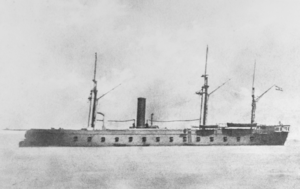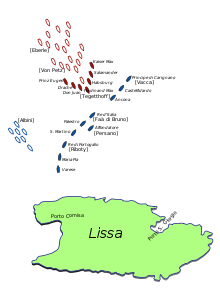SMS Kaiser Max (1862)
SMS Kaiser Max was the lead ship of the Kaiser Max class of armored frigates built for the Austrian Navy in the 1860s. Her keel was laid in October 1861 at the Stabilimento Tecnico Triestino shipyard; she was launched in March 1862, and was completed in 1863. She carried her main battery—composed of sixteen 48-pounder guns and fifteen 24-pounders—in a traditional broadside arrangement, protected by an armored belt that was 110 mm (4.3 in) thick.
 Illustration of Kaiser Max c. 1866 | |
| History | |
|---|---|
| Name: | Kaiser Max |
| Builder: | Stabilimento Tecnico Triestino |
| Laid down: | October 1861 |
| Launched: | 14 March 1862 |
| Commissioned: | 1863 |
| Fate: | Scrapped, December 1873 |
| General characteristics | |
| Class and type: | Kaiser Max class |
| Displacement: | 3,588 long tons (3,646 t) |
| Length: | 70.78 meters (232 ft 3 in) pp |
| Beam: | 10 m (32 ft 10 in) |
| Draft: | 6.32 m (20 ft 9 in) |
| Installed power: | 1,926 indicated horsepower (1,436 kW) |
| Propulsion: | 1 single-expansion steam engine |
| Speed: | 11.4 knots (21.1 km/h; 13.1 mph) |
| Range: | 1,200 nautical miles (2,200 km; 1,400 mi) at 10 knots (19 km/h; 12 mph) |
| Crew: | 386 |
| Armament: |
|
| Armor: | Belt: 110 mm (4.3 in) |
Kaiser Max saw action at the Battle of Lissa in July 1866. She engaged the Italian coastal defense ship Palestro, which later exploded and sank after sustaining heavy Austrian fire. Kaiser Max emerged from the battle largely unscathed, save for minor damage to her funnel and rigging inflicted by the armored frigate Re d'Italia. After the war, Kaiser Max was modernized slightly in 1867 to correct her poor seakeeping and improve her armament, but she was nevertheless rapidly outpaced by naval developments in the 1860s and 1870s. Obsolescent by 1873, Kaiser Max was officially "rebuilt", though in actuality she was broken up for scrap, with only her armor plate, parts of her machinery, and other miscellaneous parts being reused in the new Kaiser Max.
Design
Kaiser Max was 70.78 meters (232 ft 3 in) long between perpendiculars; she had a beam of 10 m (32 ft 10 in) and an average draft of 6.32 m (20 ft 9 in). She displaced 3,588 long tons (3,646 t). She had a crew of 386. Her propulsion system consisted of one single-expansion steam engine that drove a single screw propeller. The number and type of her coal-fired boilers have not survived. Her engine produced a top speed of 11.4 knots (21.1 km/h; 13.1 mph) from 1,926 indicated horsepower (1,436 kW). She could steam for about 1,200 nautical miles (2,200 km; 1,400 mi) at a speed of 10 knots (19 km/h; 12 mph).[1]
Kaiser Max was a broadside ironclad, and she was armed with a main battery of sixteen 48-pounder muzzle-loading guns and fifteen 24-pounder 15 cm (5.9 in) rifled muzzle-loading guns. She also carried a single 12-pounder gun and a six-pounder. The ship's hull was sheathed with wrought iron armor that was 110 mm (4 in) thick.[1]
Service history
Kaiser Max was built by the Stabilimento Tecnico Triestino (STT) shipyard; her keel was laid down in October 1861, and her completed hull was launched on 14 March 1862. Fitting-out work was completed the following year, when she was commissioned into the Austrian fleet. She proved to be very wet forward owing to her open bow, and as a result, tended to handle poorly.[1] In June 1864, she collided with the British merchant ship Rapid off the coast of Portugal, severely damaging her.[2] In June 1866, Italy declared war on Austria, as part of the Third Italian War of Independence, which was fought concurrently with the Austro-Prussian War.[3] Rear Admiral Wilhelm von Tegetthoff, the commander of the Austrian Fleet, immediately began to mobilize his fleet. As the ships became fully manned, they began to conduct training exercises in Fasana.[4] Tegetthoff brought the Austrian fleet to Ancona on 27 June, in an attempt to draw out the Italians, but the Italian commander, Admiral Carlo Pellion di Persano, refused to engage Tegetthoff.[5] Tegetthoff made another sortie on 6 July, but again could not bring the Italian fleet to battle.[6]
Battle of Lissa

On 16 July, Persano took the Italian fleet, with twelve ironclads, out of Ancona, bound for the island of Lissa, where they arrived on the 18th. With them, they brought troop transports carrying 3,000 soldiers.[3] Persano then spent the next two days bombarding the Austrian defenses of the island and unsuccessfully attempting to force a landing.[7] Tegetthoff received a series of telegrams between the 17 and 19 July notifying him of the Italian attack, which he initially believed to be a feint to draw the Austrian fleet away from its main base at Pola and Venice. By the morning of the 19th, however, he was convinced that Lissa was in fact the Italian objective, and so he requested permission to attack.[8] As Tegetthoff's fleet arrived off Lissa on the morning of 20 July, Persano's fleet was arrayed for another landing attempt. The latter's ships were divided into three groups, with only the first two able to concentrate in time to meet the Austrians.[9] Tegetthoff had arranged his ironclad ships into a wedge-shaped formation, with Kaiser Max on his left flank; the wooden warships of the second and third divisions followed behind in the same formation.[10]
While he was forming up his ships, Persano transferred from his flagship, Re d'Italia to the turret ship Affondatore. This created a gap in the Italian line, and Tegetthoff seized the opportunity to divide the Italian fleet and create a melee. He made a pass through the gap, but failed to ram any of the Italian ships, forcing him to turn around and make another attempt.[11] After the second pass, Kaiser Max engaged Re d'Italia, with the latter damaging Kaiser Max's rigging and funnel. After the Italian ship had been rammed and sunk by Erzherzog Ferdinand Max, Kaiser Max attempted to ram another Italian vessel without success. She then engaged the small coastal defense ship Palestro with fifteen broadsides. The Austrian ironclad Don Juan d'Austria then became surrounded by Italian ships, prompting Kaiser Max to come to her rescue.[12]
Around this time, Persano broke off the engagement, and though his ships still outnumbered the Austrians, he refused to counter-attack with his badly demoralized forces. In addition, the fleet was low on coal and ammunition. The Italian fleet began to withdraw, followed by the Austrians; Tegetthoff, having gotten the better of the action, kept his distance so as not to risk his success. As night began to fall, the opposing fleets disengaged completely, heading for Ancona and Pola, respectively.[13] Kaiser Max had emerged from the battle essentially undamaged, the Italian shells having been unable to penetrate her armor.[14]
Later career
After returning to Pola, Tegetthoff kept his fleet in the northern Adriatic, where it patrolled against a possible Italian attack. The Italian ships never came, and on 12 August, the two countries signed the Armistice of Cormons; this ended the fighting and led to the Treaty of Vienna. Though Austria had defeated Italy at Lissa and on land at the Battle of Custoza, Italy's ally Prussia had decisively defeated the Austrian army at the Battle of Königgrätz. As a result, Austria, which became Austria-Hungary in the Ausgleich of 1867, was forced to cede the city of Venice to Italy.[15] In the immediate aftermath of the war, the bulk of the Austrian fleet was decommissioned and disarmed.[16]
The fleet embarked on a modest modernization program after the war, primarily focused on re-arming the ironclads with new rifled guns.[17] Kaiser Max was rebuilt in 1867, particularly to correct her poor seakeeping. Her open bow was plated over and she was rearmed with twelve 7-inch (178 mm) muzzleloaders manufactured by Armstrong and two 3-inch (76 mm) 4-pounder guns. By 1873, the ship was obsolescent and had a thoroughly rotted hull, so the Austro-Hungarian Navy decided to replace the ship. Parliamentary objection to granting funds for new ships forced the navy to resort to subterfuge to replace the ship. Reconstruction projects were routinely approved by the parliament, so the navy officially "rebuilt" Kaiser Max and her sister ships. In reality, Kaiser Max was completely broken up at the STT shipyard starting in December 1873, and only some parts of the engines, her armor plate, and other miscellaneous parts were salvaged for use in the new Kaiser Max, so-named to conceal the fact that she was a new vessel.[18][19]
Notes
- Gardiner, p. 268
- "Shipping Intelligence". Caledonian Mercury (23406). Edinburgh. 13 July 1864.
- Sondhaus, p. 1
- Wilson, p. 228
- Wilson, pp. 216–218
- Wilson, p. 229
- Wilson, pp. 221–224
- Wilson, pp. 229–230
- Wilson, pp. 223–225
- Wilson, pp. 230–231
- Wilson, pp. 232–235
- Wilson, pp. 242–243
- Wilson, pp. 238–241, 250
- Wilson, p. 245
- Sondhaus, pp. 1–3
- Sondhaus, p. 8
- Sondhaus, p. 10
- Gardiner, pp. 268, 270
- Sondhaus, p. 46
References
- Gardiner, Robert, ed. (1979). Conway's All the World's Fighting Ships: 1860–1905. London: Conway Maritime Press. ISBN 0-85177-133-5.
- Sondhaus, Lawrence (1994). The Naval Policy of Austria-Hungary, 1867–1918. West Lafayette: Purdue University Press. ISBN 9781557530349.
- Wilson, Herbert Wrigley (1896). Ironclads in Action: A Sketch of Naval Warfare from 1855 to 1895. London: S. Low, Marston and Company. OCLC 1111061.